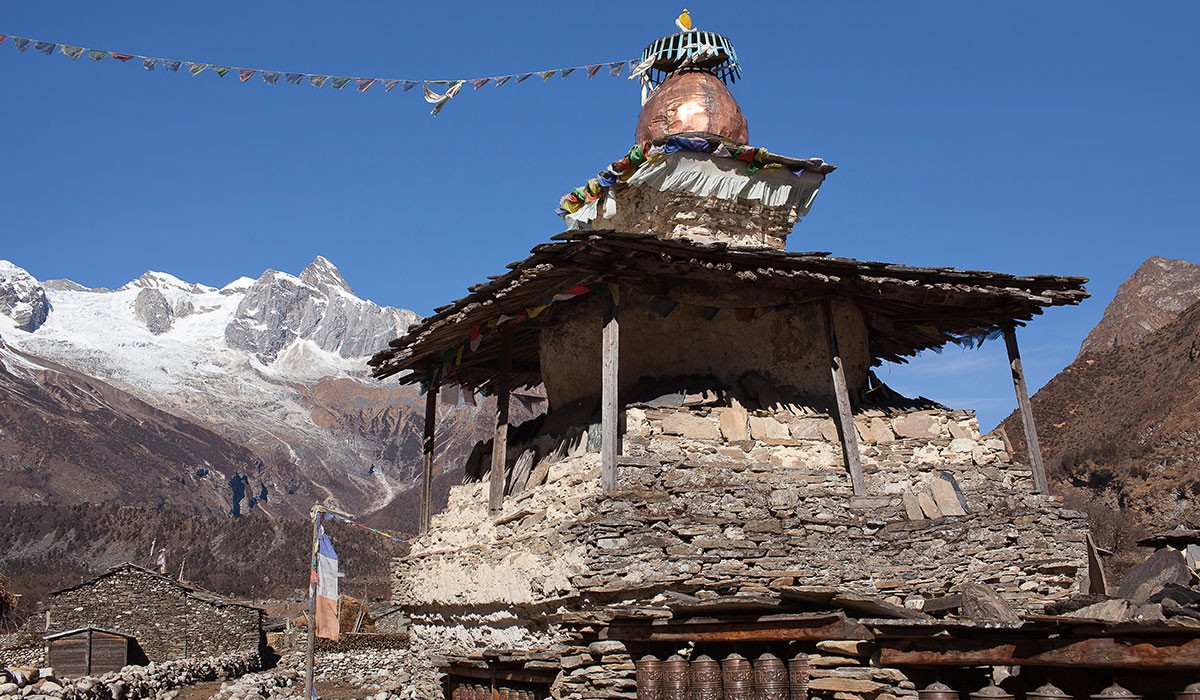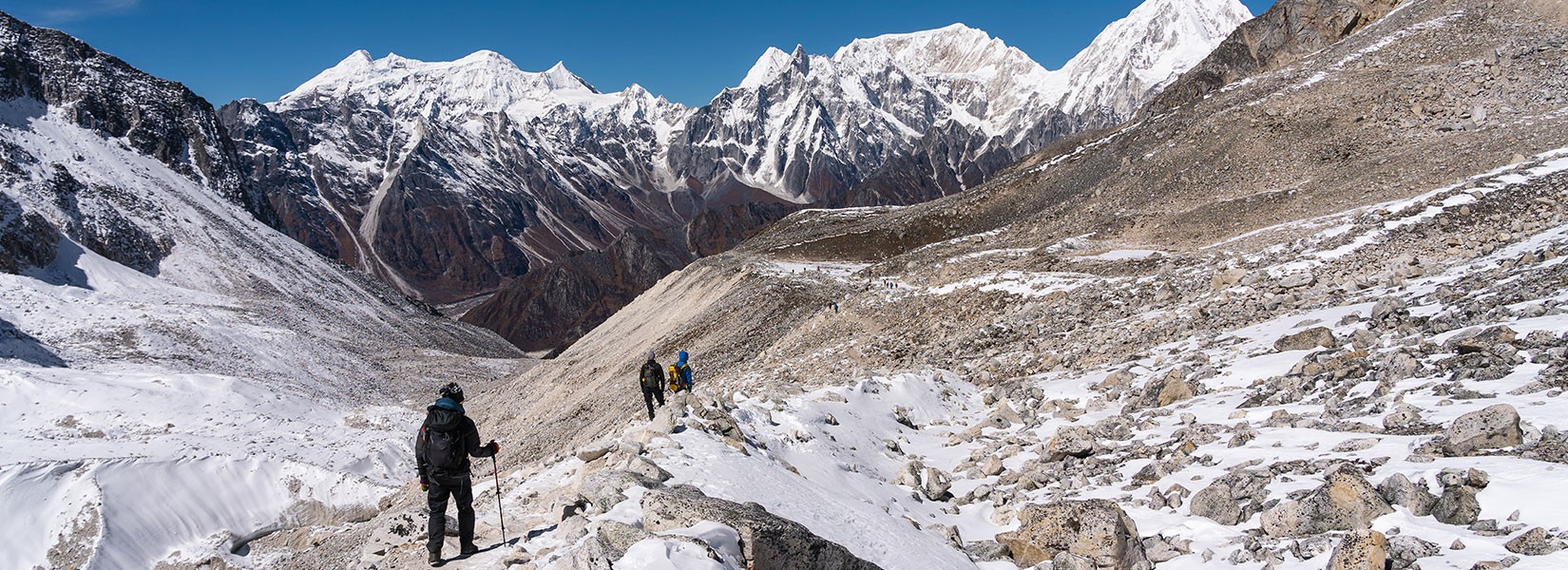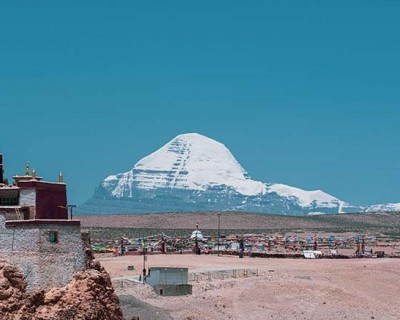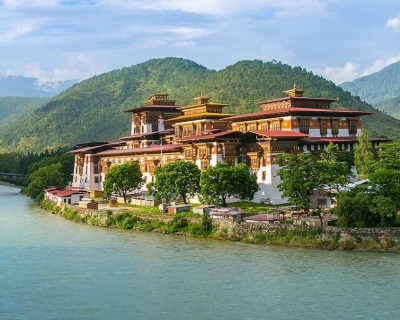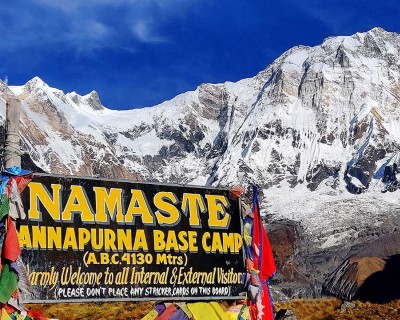Tsum Valley’s Relationship With Buddhism
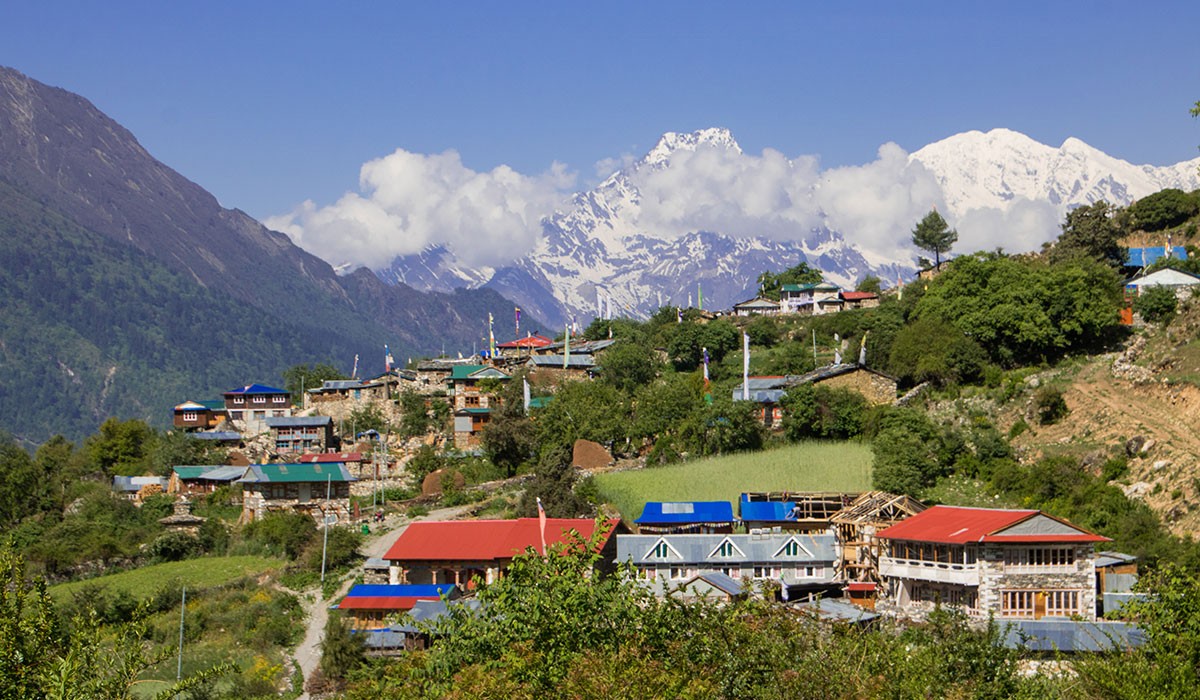
This sacred valley has a long relationship with Buddhism and shares a great significance with the religion. It is believed that during the 8th century, one of the prominent Buddhist gurus, Padma Sambar, founded 108 Beyuls in the Himalayas. Beyuls in Buddhism are the secret valleys that protect the religion and people during times of crisis. These hidden valleys are considered sacred in Buddhism, and so far, Beyuls hidden in the Himalayas have been identified in four countries: Nepal, Tibet, Bhutan, and India.
Talking about Nepal, Guru Padma Sambar established 5 Beyuls in the Nepali Himalayas. The Beyuls in Nepal are spread across five major sections in the Himalayas: Kimolung Beyul in Gorkha, Khempalung Beyul in Sankhuwasabha, Yolmo and Nagmo Beyul in Rasuwa and Khumbu Beyul in Solukhumbu. The Tsum Valley is the part of the Kimolung Beyul, which is perfectly hidden in the west-central part of the Nepali Himalayas.
Besides being one of the significant sacred valleys for Buddhism, which preserves ancient practices and traditions, the Buddhist Guru Chipchun Milarepa also left a footprint in this peaceful valley. Milarepa is one of the prominent figures in Buddhism, a student of Marpa Lotsawa, he attained enlightenment after gaining insights into the nature of reality. Milarepa later wandered around the Himalayas (mainly Tibet and Nepal), teaching the ways of Buddhism. The Buddhist monk is also the only person who has successfully climbed the holy mountain, Mount Kailash, the adobe of the Lord Shiva.
Guru Chipchun Milarepa visited the cave in Piren Phu Cave in the Tsum Valley during the 11th Century and meditated there. His footprint is set on the stone of the cave and is visited by pilgrims from all over the world. Out of 23 monasteries in this serene hidden valley, Rachen Monastery and Mu Monastery are considered to be the most significant. Both of the gompas were established in 1936 by another major Buddhist Guru, Drupa Rinpoche. Thus, this beautiful valley shares a great history with Buddhism as it is an embodiment of peace, prosperity, and sacred refuge for the true seekers of the religion, which serves the original purpose of the Beyuls.
Tsum Valley People and Culture
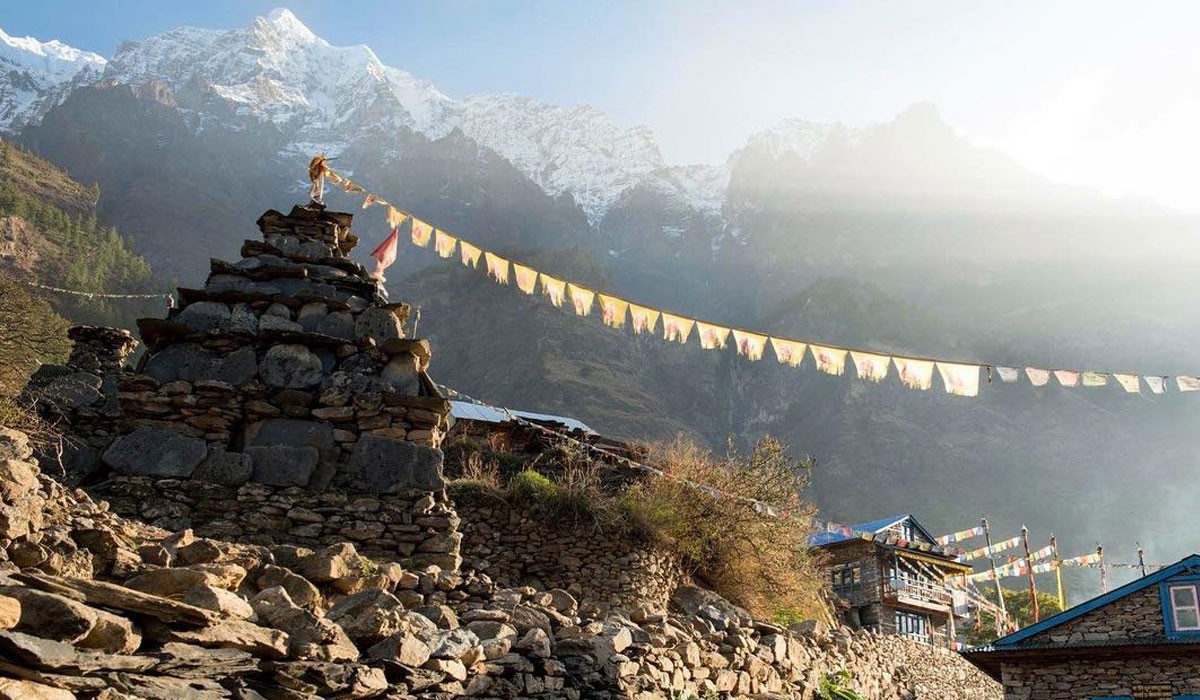
Tsum Valley was a restricted area before it was opened for tourism in 2008. This sacred valley, hidden in the lap of the Himalayas, is situated in the northern part of the Gorkha District. This district is the birthplace of the Nepali king of the Shah Dynasty, Prithvi Narayan Shah, who unified the country. The Tsum Valley previously belonged to the Chhekampar Village Development Committee, and currently, it falls under the Tsumanubri Rural Municipality. This rural municipality, including the Tsum Valley, also has two other Himalayan valleys: Kutang Valley and Numbri Valley, both of which are considered sacred.
The Tsum Valley has 18 small settlements and around 4,000 indigenous Tsumbas reside in this valley. Natives of this sacred valley are of Tibetan origin and speak unique dialects, Tsumke and Tsumba. The natives of the region practice both Buddhism and Bon Religion (an ancient Tibetan religion that has similarities with Tibetan Buddhism). The inhabitants of this peaceful valley are dependent on agriculture and animal husbandry. They also harvest Yarsagumba, which is pretty common in the valley. Although the Yarsagumba harvest is seasonal, it is quite profitable, and the natives of the valley set out in groups during the harvest season. As Yarsagumba grows in the wild without the need for tending and it fetches hefty profits of about 2,50,000 to 25,00,000 per kg, it is one of the solid sources of income for the natives.
Tourism is another major source of income in the Tsum Valley, as it is one of the most popular off-beaten trekking experiences in the Himalayas. Manaslu Region is one of the most beloved remote explorations for untampered wilderness exploration, and Tsum Valley is an iconic landmark of this remote exploration. Although the Tsum Valley Trek can be done separately, most trekkers, with enough time, go for both the Manaslu Circuit and Tsum Valley Trek at once.
Story Behind Ban of Animal Sacrifice: Shayagya Tradition
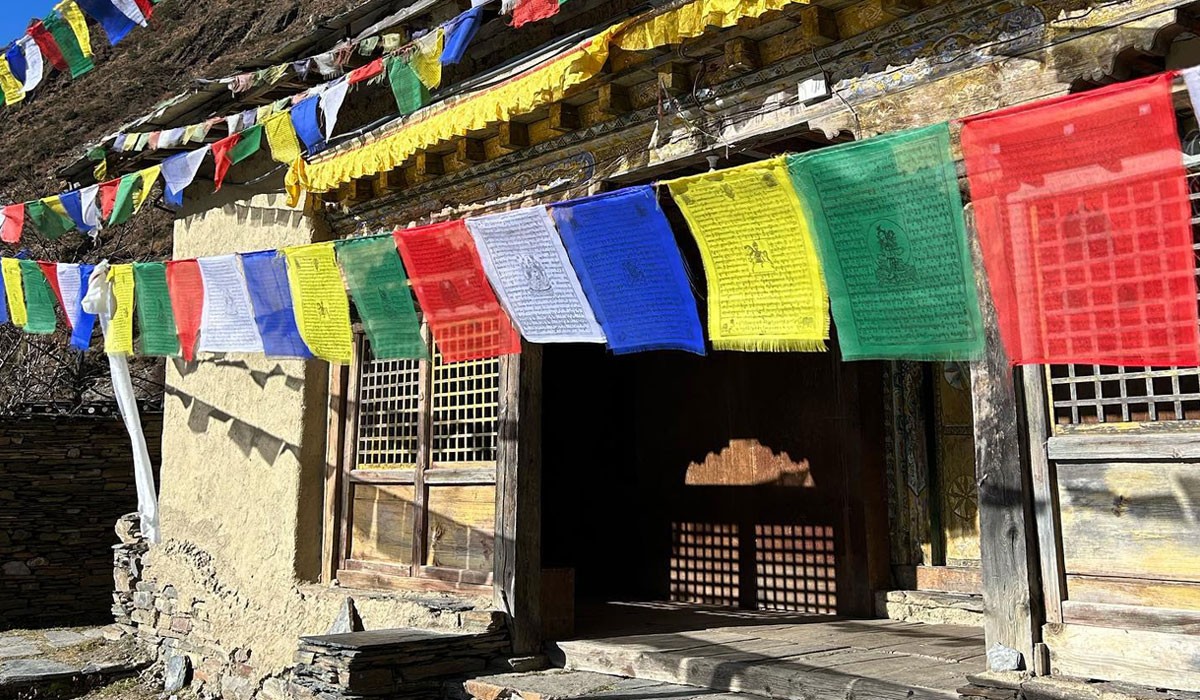
Tsum Valley was declared as Shayagya ‘a non-violent area’ by the inhabitants in 1920. The Shayagya Tradition bans the sacrifice of animals as well as any potential harm to the animals and nature. Inhabitants also cannot sell domesticated animals for eating purposes. This tradition started in the Tsum Valley on the occasion of Buddha Jayanti, which is known as ‘Saka Dawa’ in Tibetan, in 1977 B.S. Mahaguru Dukpa Lama Serap Dorje was at the forefront of the establishment of this tradition in accordance with the inhabitants.
On the occasion of the Buddha Jayanti, the Mahaguru Dorje gathered the residents of the Tsum Valley to make the views not to hurt or cause harm to living beings and nature. Six iron-clad rules of non-violence were founded on this day:
- No hunting of the life forms
- No setting traps
- No killing of any living beings
- No collecting honey
- No selling of domesticated animals for eating purposes
- No setting fire in the forest
These rules promote the co-existence among the living beings of every form and harmonious living. The establishment of this peaceful tradition also had a pretty interesting start. Before the Shayagya tradition, the inhabitants of the region used to hunt wild animals for food, but an incident changed everything. One day, a hunter and his dog were chasing a deer; the deer entered the Tsum Valley and got inside the shelter of a meditating Lama. Then, the Lama provides religious insights to the hunter, who then vows never to hurt animals again.
The level of understanding shown by the animal and adhering to the basics of Buddhism that vows to never hurt a living being, the inhabitants then later decided to adopt the non-violence practice. Although the commitment was made in Tibetan Sambhota Script in 1977 B.S., the commitment among the inhabitants was repeated again in 1996 B.S. and 2027 B.S. The commitment was later written down in Nepali Devanagari Script in 2029 B.S. To celebrate the peaceful commitment of the inhabitants, the first cultural festival was organized in 2055 B.S. Although the Shayagya tradition was in practice in the Tsum Valley for over a century, it didn’t receive any legal status. However, in 2079, the Tsumanubri Rural Municipality passed the Tsum Shayagya Act making it a legal obligation in the sacred valley.
Geographical Features of Tsum Valley
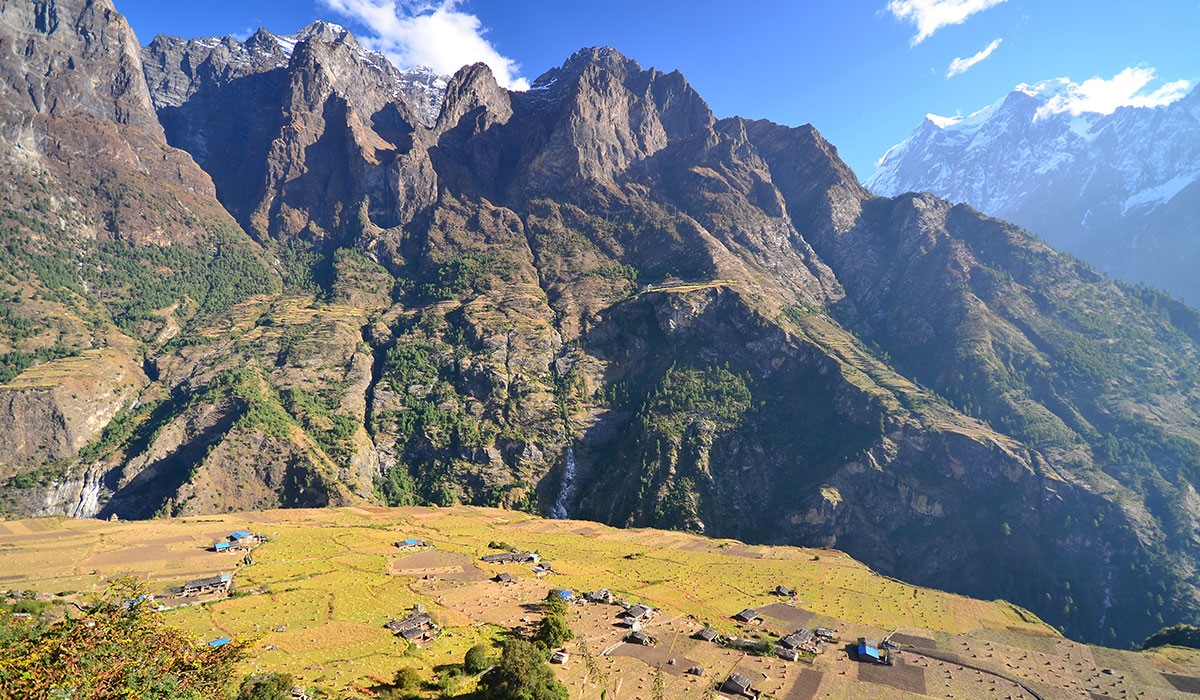
Tsum Valley is located in the Manaslu Conservation Area and occupies an area of 1,662 square km. Nestled in the Himalayas, this sacred valley is surrounded by pristine peaks; from this beautiful valley, you will be able to catch the incredible views of Shringi Himal, Ngadi Chuli, Buddha Himal, Ganesh Himal, Manaslu and many more. The elevation point of the Tsum Valley lies between 1,600 meters (5,249 feet) to 3,700 meters(12,139 feet). As the valley is located inside a Himalayan conservation area, the sightseeing of endangered wildlife like musk deer, Himalayan tahr, blue sheep, and snow leopard is pretty common.
This beautiful hidden valley in the Himalayas also houses around 2,000 species of plants, including 50 species of medical plants, 33 species of mammals, and 110 species of birds. Tsum Valley is majorly divided into two parts: Chumling (Lower Tsum) and Chhaikampar (Upper Tsum) where the majority of the population resides between the altitude of 1,905 meters to 3,100 meters. Due to the extreme altitudes and cold climatic conditions that are mostly covered with snow, the crops can be only grown once per year in the Tsum Valley. So, only crops like wheat, maze, buckwheat, beans, mustard, bouquet, etc are the prime agricultural production of the valley.
Tsum is also close to Tibet, the autonomous state of China; the Tibetan border is located at a distance of just 15 km from Nile Village. That’s why the inhabitants of the valley have been doing trade activities with Tibet since ancient. As there aren’t any viable transportation options available, the yak herbs import and export the goods. Due to its difficult landscapes, the sacred valley hasn’t been affected by modernization at all, and the residents are still adept at the practices and the Himalayan lifestyle that has been passed down for centuries.
Gain Insights On:
Governance and Hierarchy
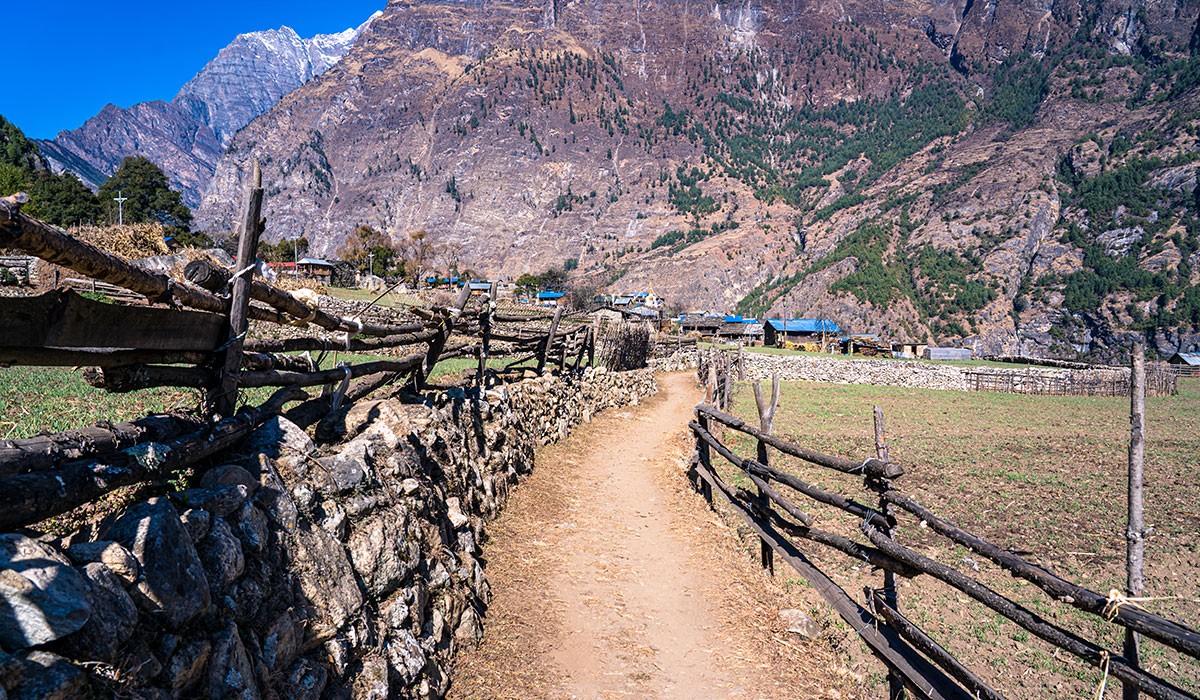
The Tsum Valley is governed by several institutions, like the government, sem-government institutions, and other local committees and groups known as the Conservation Area Management Committees formed by the Manaslu Conservation Area Project. The customary institutions of Tsumba and village assembly nominate the customary community leaders such as Ghenchen (the village leader), Syara (the clan leaders), and Chyange (the supporters of the village leader). These personnel are responsible for enforcing the community decisions and rules in the valley.
Similarly, the natives have a Lama (spiritual leader) who takes care of the religious rituals and is a significant part of the society to preserve the cultural practices and spirituality. These spiritual leaders are the most respected people in the valley, and choosing the path of monk or nun is highly respected. The Lama also are classified into several categories and have their own set of duties as per the assigned role. The Parang Lama is a local Lama who performs rituals in the village. The Autari Lama (Lama in a monastery) performs the religious celebration and also oversees teaching to the monks who are pursuing the path of peace.
As for the medical aspects, the traditional doctors of the Tsum Valley are known as Amchi. The knowledge of these traditional doctors on the use of herbal medicine has helped to balance the social structure in the sacred valley. They are the only personnel who have the exclusive right to collect and distribute herbal medicine in the valley. Like Lama, there are also several types of Amchi that serve their specific purpose. There are Amchi Priests who oversee the medication for the villagers, priests who tend the domestic animals, and finally, the priests who prepare treatments for poison.
Legend of Yeti
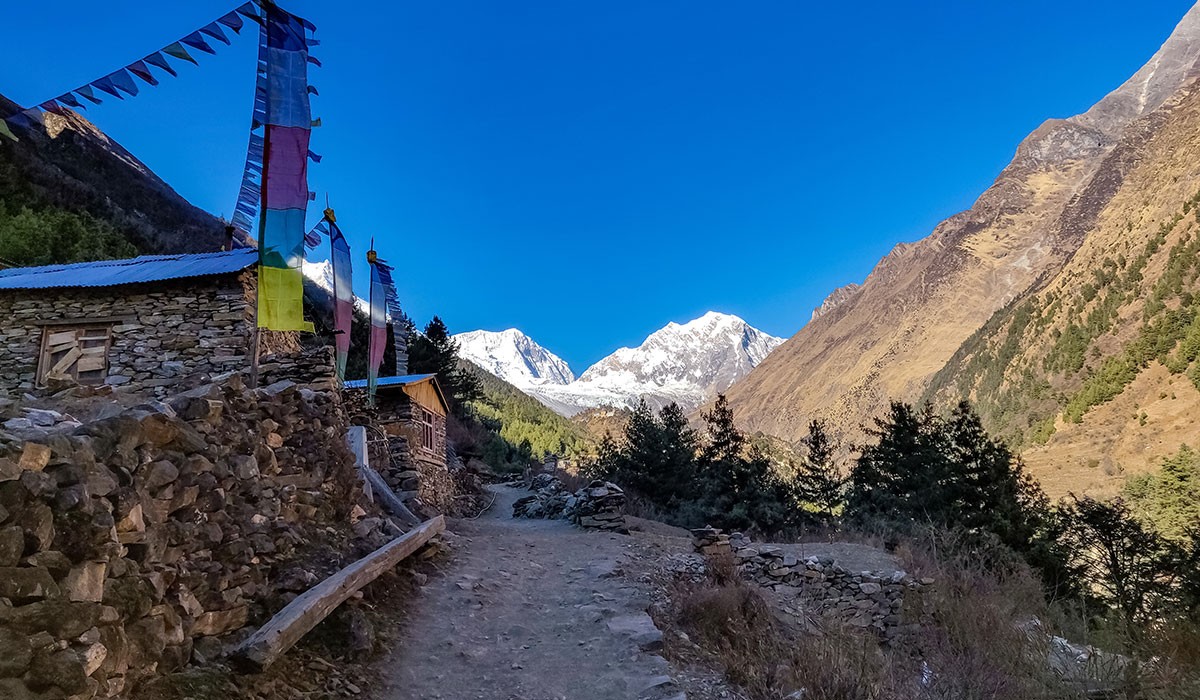
One of the fascinating and notable things about this sacred valley is its ties with the mystical creature referred to as Mehti by the inhabitants and as ‘Yeti’ or the ‘Abominable Snowman’ in the West. As the Tsum Valley is also home to the rare species of the Himalayan brown bear, the mystical creature ‘Yeti’ is also considered to be a species of these eloped bears. Although, there has been no recorded evidence of these mystical creatures, many of the natives of the Tsum Valley claim to have seen the Abominable Snowman.
The local communities have shared the details of their encounter with the large ape-like creatures in the mountains Although there have been reported sightseeing of the Yeti and the alleged footprints belonging to the mystical mountain creature, there still isn’t any concrete scientific evidence to prove its existence. Regardless of that, the stories of sightseeing have been passed down for generations, and they create a vivid picture of the mythical beast that is both feared and revered by the inhabitants of the Tsum Valley. This silent guardian of the valley that hides amidst the mountain, whether it's real or not, is of great significance to the natives of the Tsum Valley.
Rachen Gompa/ Nunnery
The Rachen Nunnery, which is situated at the center of the Beyul Valley, was established by Drupa Rinpoche, a lharama geshe from Tibet. Believed to be his reincarnation, the present Drupa Rinpoche took care of both the nunnery and gompa in 2002 before transferring the caretaker position to Lama Zopa Rinpoche. During the time Lama Zopa took over to take care of the two sangha communities, the monks and nuns were living under very dire circumstances. They had very little to eat, and they even slept on the bare floor; most of the nuns and monks in these sangha communities at the time were the older disciples of Geshe Lama Konchok who had meditated in these parts of the mountains for over 25 years.
After accepting the request from Drupa Rinpoche, Lama Zopa Rinpoche made a request to Kopan Monastery in Kathmandu to take care of these two communities. When the Kopan Monastery took over the caretaking positions, the circumstances drastically improved among the sangha communities. They helped to improve the living quarters, initiated a better chain of supply for food, and even started a school for the young nuns and monks in the communities. Within a year, both of the communities revied, and several young nuns and monks joined. There are about eighty young and old nuns at the Rachen Nunnery, where they mediate, study, and pray. In this nunnery, the young nuns are trained by the older group of nuns who have the knowledge and practices that have been passed down from ancient times.
The improvement of the Rachen Gompa’s circumstances has also helped to provide opportunities to the many young women in the valley. Previously, the only choice these women had was to embrace the traditional way of living: being a wife and handling responsibilities as a mother. However, now, these young women can join the school and the education program. Qualified geshe teaches Buddhist philosophy, English, simple maths, and Tibetan subjects in this nunnery, which is to be attended by all. The nunnery takes care of food, education and medical care of all the nuns. With the increase in members, new warm, spacious rooms, kitchen, dining rooms, and kitchen have been constructed at the Rachen Nunnery with the help of everybody. There is also a resident Tibet doctor in the community who takes care of the health problems of nuns and monks.
However, with the increase in the number of nuns, the space has become too small now, and a new gompa is being built to accommodate the needs of the followers. As for the original gompa, it is now being preserved as it is a treasure chest for the ancient architecture, paintings, and religious texts that have been preserved in the Rachen Gompa for centuries. If you want to participate in the guru puja inside the nunnery, it can last upto seven hours; the nuns, during the puja, chant the prayers with absolute concentration.
Mu Gompa
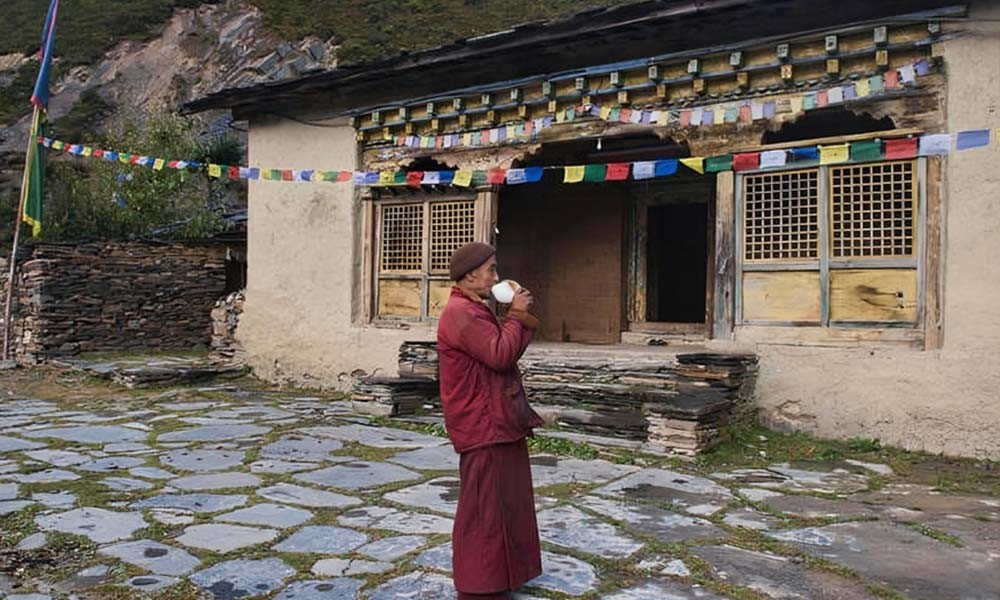
MU Gompa, which is located higher than Rachen Gompa, is at an altitude of 3,700 meters (12,139 feet). Situated at the top of the hill, this gompa is surrounded by pristine peaks and is isolated from other settlements. It takes several hours to reach the MU Gompa from the nearest settlements. Although life is tough at such altitudes, it is a wonderful place wrapped by the serenity of the Himalayas. Due to its peaceful atmosphere, it is a perfect place for meditation. Around 20 monks live in this high-altitude gompa in the Tsum Valley; they study and practice the teachings of Buddhism here. The younger monks are taught by the resident geshe, and they participate in puja and ceremonies along with them, they also provide assistance with the daily chores to the older monks.
The older monks living in the MU Gompa have been here for more than 40 years, the live-in retreat and provide guidance to the younger monks with their practices. Like the Rachen Nunnery, the young monks at the MU Gompa also learn Buddhist scriptures, philosophy, English, simple math, and Tibetan with the qualified geshe. For any festival and ceremonies, the whole MU Gompa community goes to Reachen Gompa to celebrate with other fellow members of the Buddhist teaching. The winter season typically hits the MU Gompa quite hard; it can be tough to live at such high altitudes with hardly any heating facilities and a regular food supply. Only crops like barley, millet, mustard, and potatoes can be grown at this altitude during the short summer period. So, most of the supplies have to be brought from a long distance with the help of yake and moles, mostly from the lower region of Gorkha (approximately five walk with pack horses).
During the winter season, the climate can be harsh in the 3,500-meter to 4,000-meter altitudes. So, most people in the valley migrate to lower altitudes where the climate is more pleasant. Most of the younger nuns and monks from both Rachen Gompa and MU Gompa go to Kathmandu to stay in the Kopan Monastery and Khachoe Ghakyil Nunnery, where they attend classes the same as back in their homes. These monatery and nunneries take care of their health, education, and food; the young nuns and monks learn the teaching the same way they did back in Tsum Valley but under a warmer climate. It's a pleasant change to migrate to Kathmandu during the winter season; these monks and nun can visit their families, take care of health problems, and re-stock supplies before heading back to Beyul Valley after the return of spring.
Tsum Valley Religious Arts and Architecture
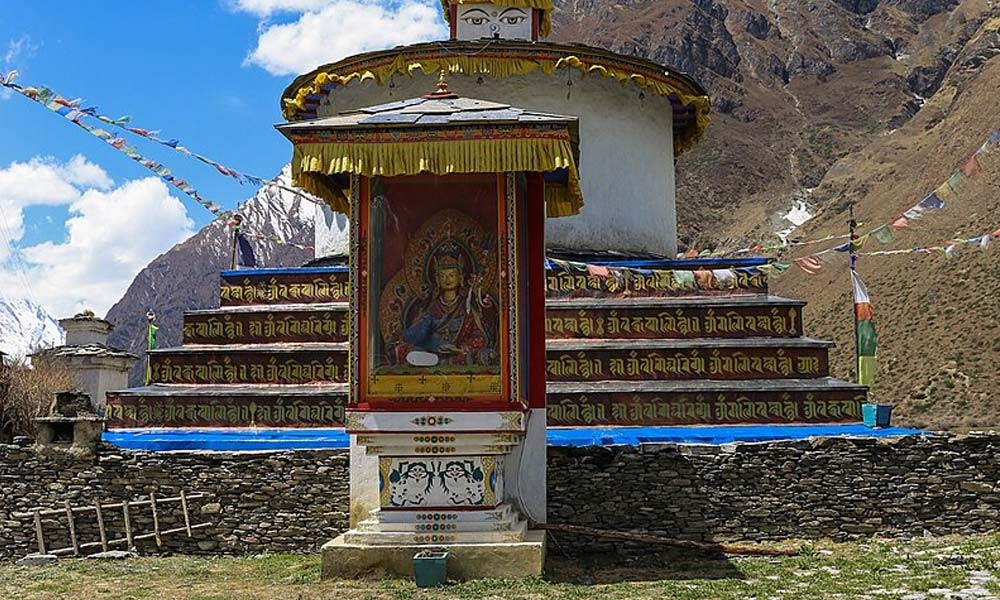
This religious Beyul Valley, which is a significant pillar of Buddhism, is also very rich when it comes to religious arts and architecture. During your venture into this sacred valley, you will get the opportunity to witness the marvelous works of art and architecture massively influenced by the Tibetan Buddhist culture. This valley of peace houses various religious arts and architecture like Chortens, Mani Walls, Kaanis, Mani Tungyur, Mani Lakor, Chakang, Lungta, etc. These religious arts don’t only preserve the cultural identities of the natives, but they are also the embodiment of cultural and spiritual values. One of the prominent examples of the religious arts and architecture preserved in the valley is the Milarepa Cave, which is situated at the rigged cliff near Burji Village of Upper Tsum Valley.
According to the legends passed down among natives, Guru Milarepa, who mediated in the cave during the 11th century, used to disguise himself and beg for food. One of the women in the valley treated him badly and just offered half of a buckwheat bread, and her field became half-barren. There is also a piece of land in the Burji where, amidst the fertile lands, there is a small piece of land that is still barren. There are stone carvings inside the cave, scripts on stones and ceiling, and also a petrified footprint of Milarepa that has been preserved to this date.
Tsum Valley Religious Arts and Architecture
| Type of Art and Architecture | Numbers in Tsum Valley | Basic Features | Purpose |
| Gompas | 15 | Large building | Special puja and ceremonies are held here |
| Village Gompas | 37 | Small building | Regular prayers and puja |
| Chorten | 2 | Cylinder-shaped small buildings made of stone of stone crafts, usually placed at the center of village and mountain passes | A peaceful retreat space that wards of the evil spirit |
| Kaanis | 25 | Erected entry gate with stonen and wood crafts | Protects villages and travelers from evil spirits |
| Mani Bumpa | Around 150 | Pagoda-style art made with stone carved with mantras on the village trails | Protects travelers and villages |
| Mani Walls | Around 50 | Longwall made of stone carved with religious scriptures | Ward of the evil spirits on the trail |
| Mani Tungyur | 20 | Cylinder-shaped praying wheels placed in gompas | Protection from the evil spirit |
| Purkhang | 5 | Stones erected on top of the hills that look like Chorten near gompas | For commemorating visits or death of significant figures like Lamas |
Besides these, there are also several Mani Lakor, a small prayer wheel that is placed around the circumnavigating paths of the mani walls. These praying wheels are believed to help one to protect themselves from the evil spirit. Similarly, Lungta is another religious art where stone and praying flags are used to mark the top of the main passes. These religious symbols ward off the evil spirit from the path. Chakang, which can seen on the side of the village trail, is a stupa created with clay, stone, and mud. These stupas are erected as the memory of the deceased and the members of the family and as a path to their salvation.
Religious Festivals and Pujas
In this sacred Beyul valley, the natives celebrate a wide range of festivals. The praying ritual, which is called puja, is carried throughout the year. These daily rituals are considered to preserve the century-old culture, traditions, and religious beliefs. The procedure for general puja at gompas is pretty standard, but during any major celebration, the gompas, villages, and even the trails are decorated. During the festivals, prayers are included, but the celebration extends to other activities as well, such as the decoration of monasteries and religious sites, visiting Buddhist pilgrimage sites, playing religious instruments, burning butter lamps, performing ritual dance, etc.
These festivals and celebrations of the natives of Tsum Valley not only strengthen the people’s spiritual relation with nature but also continuously preserve the spiritual beliefs and traditions passed down from ancient times. Here are some of the major festivals celebrated in the Tsum Valley.
| Name of Festival/ Puja | Occurrence Date | Celebrating Way |
| Losar | January/ February | A new year celebration which is celebrated for 10 to 15 days, exchanging greeting, eating and offering delicious meals, and decorating monasteries with new praying flags |
| Nara | Thosing Labrang Nara in January and Khansar Nara in June | A two-day celebration where pujas are held at gompas and masked dance is performed (believed to free people from evil spirits and bring salvation to the deceased people) |
| Dhachyang | December/ January | Visiting monasteries to offer prayers in traditional attire and jewelry (well-decorated horses are hidden during this festival) |
| Shyakya | During special occasions (exact dates are not set) | Commemoration of the non-violence Shayagya Tradition (Saka Dawa puja is performed to show villagers’ commitment toward the tradition. |
| Mani Tyungyur | Every month during the full moon (Purnima) | Married women gather in monasteries to offer prayer and recite mantras (they burn butter lamps and pray for the betterment of their life and family) |
| Lahkhang | During special occasions (exact dates are not set) | A ceremonial puja that is performed at the village gompas at least 6 to 7 times throughout the year |
| Saka Dawa | May | Celebration of Buddha’s birthday, a special puja allied Ngyungne is performed (villagers visit Buddhist monasteries, fast on alternative days, burn butter lamps, perform cultural rituals, and even build mani walls along the trail) |
| Yaarney | August | 45 days of fasting performed by nuns, monks, and Lama (holy scriptures are recited to spread peace to the world) |
| Dukpa Chhesi | August | Married women gather and celebrate this festival in the same way as the Mani Tyungyur |
| Farning | August | Various nutritious, healthy, and tasty foods are consumed to mark the attainment of the internal energy |
| Lwahwaak | October/ November | Special Ngyungne puja is performed just like Saka Dawa (alternative days fasting for the puja) |
